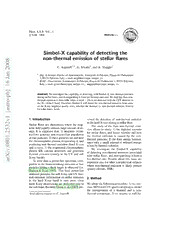
Simbol-X capability of detecting the non-thermal emission of stellar flares PDF
Preview Simbol-X capability of detecting the non-thermal emission of stellar flares
Mem.S.A.It.Vol.,1 (cid:13)c SAIt 2004 Memoriedella Simbol-X apability of dete ting the 8 non-thermal emission of stellar (cid:13)ares 0 0 C.Argiroffi1,2,G.Micela2,andA.Maggio2 2 n a 1 Dip.diScienzeFisicheedAstronomiche,Universita` diPalermo,PiazzadelParlamento J 1,90134Palermo,Italy,e-mail:[email protected] 6 2 INAF-OsservatorioAstronomicodiPalermo,PiazzadelParlamento1,90134Palermo, 1 Italy,e-mail:[email protected], [email protected] ] h Abstract.Weinvestigatethecapabilityofdetecting,withSimbol-X,non-thermalemission p duringstellarflares,anddistinguishingitfromhotthermalemission.Wefindthatflarenon- - o thermalemissionisdetectablewhenatleast∼20ctsaredetectedwiththeCZTdetectorin r the20−80keVband.ThereforeSimbol-Xwilldetectthenon-thermalemissionfromsome st of theX-raybrightestnearby stars,whetherthethermalvs. non-thermal relation,derived a forsolarflares,holds. [ 1 v 1. Introduction sented the detection of non-thermal emission 2 inthehardX-raysduringastellarflare. Stellar flares are phenomena where the mag- 3 The study of the flare non-thermal emis- 5 neticfieldrapidlyreleaseslargeamountofen- sion allows to study: 1) the depicted scenario 2 ergy. It is supposed that: 1) magnetic recon- for stellar flares, and hence whether and how . nections generate non-maxwellian population 1 the thermal emission is caused by the non- offastparticles;2)theseparticleshitandheat 0 thermal particles; 2) the flare energy balance, 8 thechromosphericplasma,evaporatingit, and since only a small amount of released energy 0 producingnon-thermalemission (hard X-rays islostbythermalradiation. : and γ-rays); 3) the evaporated chromospheric v We investigate the Simbol-X capability plasma fills coronal structures and generates i of detecting non-thermal emission associated X thermal emission (mostly in the UV and soft withstellarflares,anddistinguishingitfroma r X-raybands). hot thermal one. Results about this issue are a In solar data a power-law spectrum, com- importantalsoforotherastrophysicalsubjects patible to the bremsstrahlungemission of fast where non-thermal emission is likely present particleshittingathicktarget,isobserved(i.e. (galaxyclusters,SNR). Hudson&Ryan 1995). This hard power-law emissionprecedesthesoftX-rayandUVther- mal emission.Informationon stellar emission 2. Method in the hard X-ray band is very poor, since mostX-rayobservationsarededicatedonlyto Weadoptthefollowingprocedure:1)wesim- thesoftband.RecentlyOstenetal.(2007)pre- ulateMPDandCZTspectraadoptingasmodel the superposition of a thermal and a non- Sendoffprintrequeststo:C.Argiroffi thermalcomponent;2) we assume as nullhy- 2 C.Argiroffietal.:Detectingthenon-thermalemissionofstellarflares Table1.Modelparameters Name D EM T logLa XT (pc) (1050cm−3) (MK) (erg/s) ProxCen 1.3 5 20 27.5 ADLeo 4.7 10 20 27.7 EVLac 5.0 2×102 20 28.9 ABDor 14.9 2×102 20 29.0 HR1099 29.0 1×103 20 29.6 PMSstars 150 5×104 20 31.3 aLXTiscomputedinthe1.55−12.4keVband. pothesis that the simulated spectra can be de- scribed by thermal components only; hence Fig.1. One of the model adopted for simulating we fit simultaneously MPD and CZT spectra flarespectra. adoptinga2-T opticallythinplasmaasmodel; 3) we assume thatthe null hypothesisof only thermal emission is rejected, and hence non- thermal emission is detected and recognized, when the EMof the hottestcomponentis sig- nificantlygreaterthanzeroanditstemperature islargerthan300MK. ToproducesimulatedMPDandCZTspec- tra we consider typicalflares of nearby active stars. We are not interested in time resolved spectroscopy, hence we consider all the pa- rametersas time-averagedoverthe flaredura- tion. In all cases we consider a flare duration of 20ks. For each star we produce different Fig.2.Luminosityofthethermalandnon-thermal simulatedspectra:wekeepfrozenthethermal componentfortheflaresampleanalyzed.Grayarea component,and vary the normalizationof the marksthesolarflarerange. non-thermalcomponent.Withthischoicefora fixedthermalemissioncomponentweareable nizedwithSimbol-Xobservationswhetherthe to check the amount of non-thermalemission CZTdetectorcollectsmorethan∼ 20photons neededtodetectit. inthe20−80keVband. We use the mekal XSPEC model to sim- For each simulated spectrum we compute ulate the thermal component (Table 1 con- the thermal and non-thermal luminosity. We tains the parameters of the thermal emission compare the results obtained with those de- fortheselectedstellartargets).Wesimulatethe rivedfromsolarflaresbyIsolaetal.(2007,see non-thermalemission using the brokenpower Fig.5).Wefindthatforsomeoftheconsidered lawXSPECmodel(bknpower).Weassume:a flaresthenon-thermalemissioncanbedetected photonindexof3forE < E0,inordertohave withSimbol-Xifthermalvs.non-thermalsolar a negligible contribution of the non-thermal flarerelationisvalidalsoathighluminosities. componentat low energy;a breakpoint E = 0 10keV; a photon index of -2 for E > E . 0 References Figure1showsoneoftheexploredmodels. Hudson,H.&Ryan,J.1995,ARA&A,33,239 Isola, C., Favata, F., Micela, G., & Hudson, 3. Resultsandconclusions H.S.2007,A&A,472,261 Inspectingallthesimulatedflareswefindthat: Osten,R.A.,Drake,S.,Tueller,J.,etal.2007, non-thermal emission is detected and recog- ApJ,654,1052
